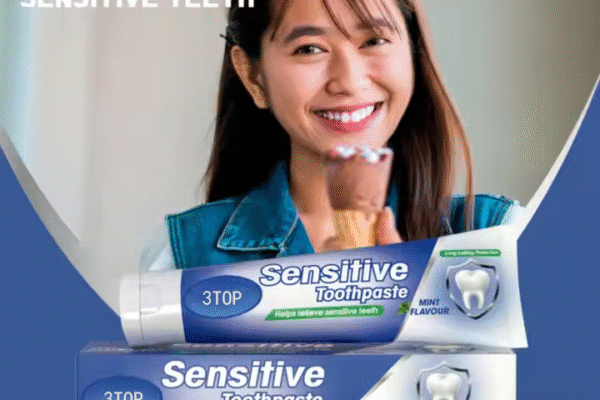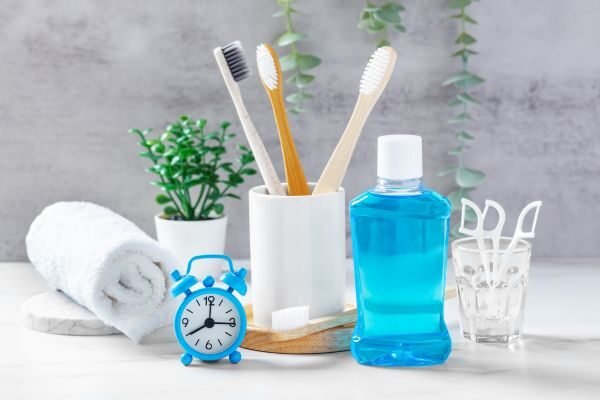Table des matières
Vous êtes-vous déjà demandé pourquoi votre haleine n'est toujours pas fraîche même après vous être brossé les dents, avoir utilisé du fil dentaire et un bain de bouche, ou pourquoi votre bouche n'est tout simplement pas propre ? La cause pourrait être votre langue. L'Association dentaire américaine rapports que 50% des adultes américains souffrent de mauvaise haleine.
Le problème avec votre langue, c'est qu'elle accumule des bactéries, des débris alimentaires et des cellules mortes, ce qui peut provoquer une mauvaise haleine. C'est pourquoi vous avez besoin d'un gratte-langue.
La raison la plus évidente d'utiliser un gratte-langue est qu'il vous donne une haleine plus fraîche. Mais il améliore également le goût et contribue à une meilleure hygiène bucco-dentaire.
Si vous avez entendu parler des gratte-langues et que vous vous demandez pourquoi tout ce battage médiatique, cet article est fait pour vous. Nous vous expliquerons tout ce que vous devez savoir sur les gratte-langues : leur fonctionnement, leurs principaux avantages, comment choisir le meilleur gratte-langue et comment l'utiliser correctement.
Donc, si vous êtes une personne qui souhaite améliorer sa santé dentaire, un dentiste à la recherche de contenu fiable à partager avec ses clients, ou peut-être une marque dans le domaine bucco-dentaire qui fait des recherches sur le grattage de la langue et produits de soins bucco-dentaires, vous trouverez cet article utile.

Qu'est-ce qu'un gratte-langue ?
Un gratte-langue est un outil qui aide à nettoyer la couche blanche qui se forme à la surface de la langue. Cette couche, appelée enduit lingual, est composée de bactéries, de restes alimentaires et de cellules mortes. Ce sont là quelques-unes des principales causes du mauvais goût et de la mauvaise haleine.
La langue humaine peut contenir jusqu'à 20 milliards de bactéries, ce qui en fait l'une des parties du corps les plus riches en bactéries. C'est pourquoi un bon nettoyage de la langue est important.
Bien que les bienfaits du nettoyage de la langue ne fassent aucun doute, certains affirment qu'une brosse à dents suffirait. Cependant, le problème est que seul un gratte-langue peut atteindre l'arrière de la langue, contrairement à une brosse à dents, et c'est là que la plupart des résidus restent.
La plupart des gratte-langue sont en forme de U et conçus pour atteindre cette zone, ce qui en fait une meilleure option pour nettoyer la langue.
Le grattage de la langue est une pratique ancestrale, remontant aux anciennes pratiques ayurvédiques. On l'utilise pour toutes sortes de raisons : pour lutter contre la mauvaise haleine tenace ou simplement pour une haleine plus fraîche le matin. Aujourd'hui, même les professionnels du bien-être et les dentistes le recommandent.
Mais le meilleur avec le grattage de la langue, c'est que tout le monde peut l'intégrer à sa routine quotidienne. Cela ne prend que quelques secondes, mais laisse une sensation de fraîcheur dans la bouche.

Raisons de se gratter la langue
La langue contient des bactéries responsables des mauvaises odeurs, principalement localisées à l'arrière. Comme mentionné précédemment, les brosses à dents et le fil dentaire peuvent être efficaces pour nettoyer les dents et les gencives ; cependant, ils touchent rarement l'arrière de la langue. Pour un nettoyage optimal, il est donc essentiel d'utiliser un gratte-langue.
Voici quelques avantages du grattage de la langue :
Haleine fraîche et meilleure
L'un des avantages du grattage de la langue est une haleine plus fraîche. La couche jaune ou blanche qui recouvre la langue est composée de bactéries et de débris qui, s'ils ne sont pas éliminés, deviennent une source de mauvaises odeurs. La menthe et les sprays pour l'haleine peuvent aider à masquer l'odeur, mais le grattage en élimine la source.
Goût amélioré
Se gratter la langue peut améliorer le goût et réduire la prolifération des bactéries nocives dans la bouche. Des recherches montrent qu'il permet de mieux distinguer le sucré, l'amer, l'acide et le salé. Lorsque vos papilles gustatives ne sont pas recouvertes de couches de tartre, vous percevez mieux les saveurs des aliments et les repas deviennent plus agréables.
Amélioration de l'apparence de la langue
Le grattage de la langue peut améliorer l'apparence de votre langue et renforcer votre confiance en vous, notamment lors de conversations ou de réunions. De plus, il procure à certaines personnes un sentiment de bien-être quotidien, tout comme une bonne routine de soins de la peau vous permet de vous sentir prêt pour la journée.

Risque réduit d'infections buccales
UN étude de 2005 Des études ont montré que l'utilisation d'un gratte-langue deux fois par jour pendant 7 jours peut réduire l'incidence des streptocoques Mutans et des lactobacilles dans la bouche. Ces bactéries sont connues pour provoquer mauvaise haleine et caries. Un grattage régulier de la langue peut réduire l'accumulation bactérienne responsable d'infections buccales comme le muguet ou la gingivite.
Hygiène bucco-dentaire améliorée
Le grattage de langue, associé au brossage et à l'utilisation du fil dentaire, peut améliorer votre hygiène bucco-dentaire. Sans danger, il laisse une sensation de propreté impeccable que le brossage seul ne procure pas forcément. Il élimine les bactéries responsables de la plaque dentaire et d'autres problèmes dentaires et gingivaux, améliorant ainsi votre hygiène bucco-dentaire globale. Comme indiqué précédemment, cela ne prend que quelques secondes, mais cela fait une énorme différence dans votre routine dentaire.
Les gratte-langues fonctionnent-ils ?
Bien sûr, ça marche. Et la science le prouve.
Votre langue présente de minuscules crevasses qui retiennent les particules alimentaires, les cellules mortes et les bactéries, un peu comme les petites poches des fraises. Si ces crevasses sont contaminées ou mal manipulées, des substances étranges peuvent s'y infiltrer. Avec le temps, cette accumulation peut engendrer des odeurs désagréables et même affecter vos gencives et vos dents.
Les grattoirs sont conçus pour soulever et retirer délicatement ce revêtement, laissant votre langue plus propre et votre haleine plus fraîche.
Bien que se brosser la langue avec une brosse à dents puisse être légèrement utile, cela a tendance à déplacer les dépôts plutôt qu'à les éliminer. Les grattoirs sont plus efficaces car ils exercent une pression constante et couvrent une plus grande surface. étude de 2004 ont montré que le grattage est plus efficace pour éliminer les bactéries responsables des odeurs que le brossage.
Selon WebMDL'utilisation d'un gratte-langue peut réduire les composés soufrés volatils (CSV), les gaz responsables de la mauvaise haleine. étude Une étude publiée dans le Journal of Periodontology a révélé que le grattage de la langue réduisait ces gaz jusqu'à 75%, contre seulement 45% avec une brosse à dents ordinaire.
Il n'est donc pas surprenant que certains professionnels dentaires recommandent désormais l'utilisation de gratte-langue comme complément simple et économique à votre routine d'hygiène bucco-dentaire. Selon l'American Dental Association (ADA), il n'y a aucun mal à intégrer le gratte-langue à votre routine dentaire.
Bien qu’il n’y ait pas d’accord parmi les chercheurs sur l’efficacité de l’utilisation des gratte-langue, le consensus est que les gratte-langue n’endommagent pas votre langue.

Comment choisir un gratte-langue
Il existe tellement d'options disponibles qu'il peut être difficile de trouver le grattoir adapté à vos besoins. Mais une fois que vous savez ce qu'il faut rechercher, choisir le bon est facile.
Commencez par la forme et le design. Un bon grattoir doit avoir un bord lisse, large et incurvé qui glisse confortablement sur la langue. Évitez les objets pointus ou trop étroits ; ils sont souvent inconfortables et moins efficaces.
Les gratte-langues sont disponibles dans plusieurs matériaux différents :
- Grattoirs en plastique:C'est une solution économique, légère et très simple pour ceux qui voyagent fréquemment. Si vous débutez avec le grattage de la langue, c'est une bonne option. Cependant, leur durée de vie peut être courte et ils peuvent s'user avec le temps.
- Un gratte-langue en cuivre: Ils plaisent à ceux qui privilégient les matériaux naturels. Le cuivre est naturellement antimicrobien, ce qui signifie qu'il aide à résister aux bactéries entre chaque utilisation. Il est utilisé depuis des siècles dans les rituels de bien-être traditionnels. Veillez simplement à le garder propre et sec pour éviter qu'il ne ternisse.
- Grattoirs en acier inoxydable: C'est l'option la plus durable. Faciles à nettoyer – certains passent même au lave-vaisselle –, ils offrent une sensation de grattage ferme et uniforme. Si vous recherchez un produit durable, c'est un excellent choix.
Vous hésitez sur le modèle à choisir ? Essayez-en plusieurs et voyez ce qui vous convient. Certains préfèrent la souplesse du plastique, d'autres la robustesse d'un gratte-langue en métal ou l'aspect naturel du cuivre.
Quel que soit votre choix, soyez constant. Un grattoir de qualité ne fonctionne que si vous l'utilisez régulièrement. Vous pouvez également prendre en compte des facteurs tels que la marque ou le modèle. fabricant de gratte-langue pour aider à la sélection.

Comment utiliser un gratte-langue
Voici un processus simple, étape par étape, sur la façon d'utiliser correctement un gratte-langue :
Étape 1 : Rincer le grattoir
Avant de commencer, rincez le scarificateur à l'eau tiède pour vous assurer qu'il est propre et prêt à l'emploi.
Étape 2 : Tirez la langue
Pour un résultat parfait, vous devez avoir un accès complet, notamment à l'arrière de la langue, où la plupart des dépôts s'accumulent au fil du temps. Ouvrez la bouche et tirez la langue. La première fois, faites-le devant un miroir pour bien voir ce que vous faites.
Étape 3 : Positionner le grattoir
Placez délicatement le bord incurvé à l'arrière de votre langue. N'appuyez pas trop loin pour éviter de déclencher un haut-le-cœur. Si vous avez envie de vomir, vous pouvez commencer par le milieu de votre langue.
Étape 4 : Grattez vers l'avant
Tirez le grattoir lentement et délicatement vers le bout de la langue. Appliquez une pression légère et uniforme ; inutile d'appuyer trop fort pour obtenir des résultats. Déplacez-vous toujours de l'arrière de la langue vers le bout. Si le grattoir vous coupe la langue ou vous fait mal, il est possible que vous exerciez une pression excessive.
Étape 5 : Rincer et répéter
Après chaque grattage, rincez le grattoir à l'eau courante. Répétez le mouvement 2 à 3 fois, ou plus si votre langue est très chargée ou décolorée.
Étape 6 : Rincez-vous la bouche
Terminez en vous rinçant la bouche avec de l’eau ou un bain de bouche pour éliminer tout résidu détaché ou toute bactérie persistante.

Conseils pour de meilleurs résultats
- Grattez-vous les dents avant de vous brosser les dents pour éliminer les bactéries en premier.
- Soyez doux et cohérent.
- Choisissez un matériau qui glisse facilement et qui est confortable.
- Nettoyez votre grattoir après chaque utilisation pour éviter les germes.
En vous grattant la langue dès le matin, vous éliminez les dépôts de la nuit et commencez la journée avec une bouche plus propre. Vous pouvez également vous gratter la langue après les repas ou avant de vous coucher, selon votre convenance.
Erreurs d'utilisation courantes
Utiliser un grattoir est facile, mais de petites erreurs peuvent le rendre moins efficace ou inconfortable. Pour obtenir les meilleurs résultats, évitez les points suivants :
- Gratter trop fort :Cela peut irriter votre langue ou provoquer de petites coupures. Exercez une pression légère et constante.
- Sauter l'arrière de la langue :La plupart des bactéries responsables des odeurs se trouvent à l'arrière. Éviter cette zone peut entraîner une accumulation. Expirez en raclant et procédez lentement.
- Ne pas nettoyer correctement votre grattoir :Assurez-vous de bien le rincer après chaque utilisation. Une fois par semaine, lavez-le à l'eau et au savon ou trempez-le dans un désinfectant doux.
- Ne l'utiliser qu'occasionnellement :Le grattage de la langue est plus efficace lorsqu'il est pratiqué quotidiennement. Une utilisation occasionnelle ne donnera pas les meilleurs résultats ni les meilleurs bienfaits.
- Partage de Scrapers :Ne partagez jamais votre grattoir, même rincé. Il propage les bactéries et met en danger votre santé bucco-dentaire.
- Utilisation d'un grattoir endommagé ou rouillé :Remplacez les grattoirs émoussés, tordus ou rouillés. Des outils endommagés peuvent rayer le grattoir ou en réduire l'efficacité.

Conseils pour éviter les haut-le-cœur lors de l'utilisation d'un gratte-langue
L'un des problèmes les plus courants liés au grattage de la langue est la stimulation du réflexe nauséeux. Cependant, l'utilisation d'un gratte-langue plat et anatomiquement précis réduit le risque de haut-le-cœur. Le réflexe nauséeux est généralement déclenché lorsque le gratte-langue entre en contact avec le palais.
Il est également essentiel de commencer doucement et d'éviter de pousser le gratte-langue trop loin. Il est conseillé de commencer par le milieu de la langue. Vous pouvez ensuite progresser vers l'arrière de la langue, en vous habituant à la sensation du gratte-langue dans la bouche sans nausées. Respirez par la bouche pendant le grattage. Si nécessaire, essayez un gratte-langue plus petit ou plus doux. La plupart des gens s'habituent en quelques jours.
Idées fausses
Voici trois idées fausses qui empêchent souvent les gens de se gratter la langue.
- Se brosser la langue est tout aussi bénéfique : Pas tout à fait. Les brosses à dents étalent les débris, tandis que les grattoirs les soulèvent et les éliminent plus efficacement.
- Vous n'avez besoin de gratter que si vous avez mauvaise haleine :Faux. Le grattage améliore également le goût, réduit les bactéries et améliore l'hygiène bucco-dentaire.
- Les outils de grattage sont inconfortables :Si vous avez mal, cela signifie que vous appuyez trop fort ou que vous utilisez le mauvais outil. La sensation doit être douce et facile. Bien qu'il soit possible de se couper ou de se blesser la langue avec un gratte-langue accidentellement, cela ne devrait pas arriver régulièrement. Vérifiez toujours que votre gratte-langue ne présente pas de bords irréguliers ou rugueux avant chaque utilisation. Si vous en trouvez, il n'est plus sécuritaire de l'utiliser. Se gratter la langue peut également être douloureux si vous appuyez trop fort. Soyez doux lorsque vous grattez. Une légère pression suffit pour éliminer l'excès de débris sur votre langue. Commencez doucement et augmentez progressivement la pression selon vos besoins.

Comment entretenir un gratte-langue
Si vous vous demandez comment nettoyer un gratte-langue ou l'entretenir, sachez que c'est assez simple. Quelques conseils d'entretien simples garantissent son hygiène et sa sécurité d'utilisation. Voici quelques conseils :
- Rincer après chaque utilisation.
- Nettoyage en profondeur chaque semaine. Les options compatibles lave-vaisselle facilitent encore plus le nettoyage.
- Sécher complètement avant de ranger.
- Remplacez-le s'il est terne, plié ou décoloré.
Pour les gratte-langues en métal, notamment en cuivre ou en acier inoxydable, les garder au sec permet d'éviter la rouille. gratte-langue en plastique, changez-le tous les trois mois, comme vous le feriez avec votre brosse à dents.
Conclusion
Le grattage de la langue est une pratique ancestrale qui a conservé toute sa pertinence aujourd'hui. Si son efficacité n'est pas encore établie, il est généralement admis qu'il est sans danger pour la langue s'il est pratiqué correctement. La plupart des études montrent que le grattage de la langue aide à prévenir et à réduire la mauvaise haleine. Quelques secondes suffisent chaque matin, mais les bienfaits peuvent durer toute la journée. Une langue plus propre signifie moins de germes dans la bouche, une meilleure sensation gustative et un sourire plus confiant.
Cependant, assurez-vous de bien comprendre son utilisation avant de commencer. Exercez une légère pression, utilisez un gratte-langue confortable et consultez votre dentiste en cas d'inconfort ou d'irritation extrême.
Avec un gratte-langue adapté et une utilisation appropriée, vous pourrez profiter de tous les bienfaits du grattage de la langue. Si votre mauvaise haleine persiste après un certain temps d'utilisation régulière, consultez votre dentiste.
FAQ
Est-il acceptable de se gratter la langue tous les jours ?
Oui. Le grattage quotidien est sans danger et contribue à réduire les bactéries et la mauvaise haleine. Vous pouvez le faire matin et soir dans le cadre de votre hygiène bucco-dentaire. Attention toutefois à ne pas vous blesser la langue en le grattant.
Qu'est-ce qui se détache lorsque vous utilisez un gratte-langue ?
Le revêtement blanc de la langue se détache lors du grattage. Ce revêtement blanc est un mélange de bactéries, de particules alimentaires et de cellules mortes, qui peut contribuer à la mauvaise haleine et à d'autres problèmes bucco-dentaires.
Dois-je utiliser un gratte-langue avant ou après le brossage ?
Idéalement, utilisez votre gratte-langue après le brossage. Immédiatement après le brossage, il restera un peu de pâte dans votre bouche, ce qui aidera à combattre les bactéries présentes sur votre langue pendant le brossage. Vous pouvez également appliquer du dentifrice sur votre gratte-langue si vous ne l'utilisez pas immédiatement après le brossage.
Quelle est la différence entre un gratte-langue et une brosse à langue ?
Les grattoirs soulèvent et éliminent mieux les accumulations, tandis que les brosses étalent souvent les débris.
Que faut-il utiliser à la place d'un gratte-langue ?
Vous pouvez utiliser une brosse à dents pour nettoyer votre langue si vous n'avez pas de gratte-langue adapté. Même si cela ne vous donnera peut-être pas les mêmes résultats qu'un gratte-langue, cela sera utile. Cependant, n'utilisez pas la même brosse à dents que pour vos dents pour vous nettoyer la langue, car vous propageriez des bactéries nocives. Dans les cas extrêmes, vous pouvez utiliser une cuillère à bords arrondis pour gratter la couche indésirable de votre langue.







